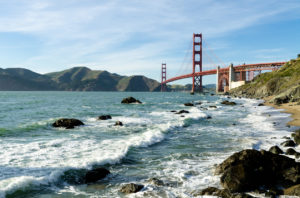
This month, we travel back to the mainland (and the home state of Miles Consulting Group) to the 3rd largest state in the country and the 6th largest economy in the world- the Golden State of California! With its sunny and dry coastal climate year round (except for January 2017!) and easy access to the ocean and mountains, California has always been seen as an ideal resort destination. In the 1960s, popular music groups such as The Beach Boys promoted the image of Californians as laid-back, tanned beach-goers – which, of course we all are!
California is home to the second most populous city in the United States- Los Angeles, which is home to the Hollywood entertainment industry. San Francisco, 400 miles to the north, is where you will find the Golden Gate Bridge, Alcatraz Island and cable cars.
The state’s terrain is very diverse and includes picturesque cliff-lined beaches, redwood forests, the Sierra Nevada Mountains, Central Valley Farmland and the Mojave Desert.
Tourists flock to California to enjoy its pristine beaches, state and national parks and theme parks. Some of the theme parks include: Disneyland, Universal Studios, LEGOLAND, Six Flags Magic Mountain, Six Flags Discovery Kingdom, Paramount’s Great America, Knott’s Berry Farm and Sea World. National parks include Yosemite, famous for its glacially carved domes and Sequoia National Park, home to the giant sequoia trees, the largest living organisms on Earth. The state is also home to Lake Tahoe, a deep freshwater lake and the largest freshwater lake in the state by volume.
Business Climate
The economy of California is large enough to be compared to that of the largest countries in the world. If it were a country, California would be the 6th largest economy in the world and the 35th most populous. It is also regarded as a global trendsetter in both popular culture and politics, and is the birthplace of the film industry, the hippie counterculture, the internet, and the personal computer. Fifty-eight percent of the state’s economy is centered on finance, government, real estate services, technology, and professional, scientific, and technical business services.
As a generator of wealth within the state, the San Francisco Bay Area has the nation’s highest median household income by metropolitan area, and is the headquarters of three of the world’s largest 20 firms by revenue: Chevron, Apple, and McKesson.
Complementing the manufacturing, intellectual and entertainment businesses, California’s agricultural industry has the highest output of any U.S. state. According to the USDA in 2011, the three largest California agricultural products by value were milk and cream, shelled almonds, and grapes.
California’s economy is also dependent on trade and international related commerce, which accounts for about one third of the state’s economy. In 2015, California exported to 229 foreign markets.
Tax Climate
California, like many states, generates income from both property tax and income tax sources. Unlike other states, however, property tax increases are restricted to no more than 2% per year under the now famous “Proposition 13” passed by the voters in 1978. On the income side, the state heavily skews tax receipts to come from the wealthiest Californians in a progressive scheme that has resulted in substantial variations in state income from this source (as wealthy individuals arrange their capital gains to their advantage).
California’s individual income tax system consists of 10 brackets with a top rate of 13.3%. The top rate ranks the highest among states levying an individual income tax. California’s state and local income tax collections per person were $1,753 in 2010, which ranked 4th highest nationally.
The state’s corporate income tax system consists of a flat rate of 8.84%. This rate ranks 8th highest among states levying a corporate income tax. California’s state and local corporate income tax collections per person were $228 in 2014 which ranked 10th highest nationally.
California levies a 7.5% general sales or use tax on consumers, substantially above the national median of 5.95%. The average local sales tax rate is an additional 0.98%. California’s state and local governments collect $1,159 per person in general sales taxes (17th nationally) and $507 per person in excise taxes (24th nationally). Additionally for consumers, California’s gasoline tax stands at 40.62 cents per gallon, 5th highest nationally, while its cigarette tax stands at $0.87, 34th highest nationally.
California’s state and local governments collected approximately $1,365 per person in property taxes in 2013, which ranks 22nd nationally.
Tax Incentives and Credits
Tax credits provide incentives to support business growth and activities in California. These include:
California Competes Tax Credit– This is an income tax credit for “high-value” businesses growing in California. The purpose is to attract and retain employers in the state in industries with high economic multipliers and that provide their employees with good wages and benefits. To read more about this tax credit, click here.
California Manufacturers Partial Exemption– Beginning on July 1, 2014, manufacturers and certain research and developers may qualify for a partial exemption of sales and use tax on manufacturing and research and development equipment purchases and leases. To be eligible for this partial exemption, you must meet all three of these conditions:
- Be engaged in certain types of business (that manufactures in a qualified NAICS code), also known as a “qualified person.”
- Purchase “qualified property.”
- Use that qualified property for the uses allowed by this law.
To read more about this tax credit, click here.
Our team at Miles Consulting Group is always available to discuss the specifics of your situation, whether in California or another U.S. State, and help you navigate the complex tax structures arising from multistate operations. Call us to help you achieve the best tax efficiencies.
Random Facts
- The Sierra Nevada Mountains bear artic temperatures in winter and are home to several dozen small glaciers, including Pallisade Glacier, the southernmost glacier in the United States.
- About 45% of the state’s total surface area is covered by forests, and the state’s diversity of pine species is unmatched by any other state.
- California contains more forestland than any other state except Alaska.
- Many of the trees in California’s White Mountains are the oldest in the world.
- California is home to the oldest college bowl game, the annual Rose Bowl.
- The state is the only U.S. state to have hosted both the Summer and Winter Olympics.
- Twenty major professional sports league franchises reside in California, far more than any other state.
- California has a border along the Pacific Ocean of nearly 900 miles.














